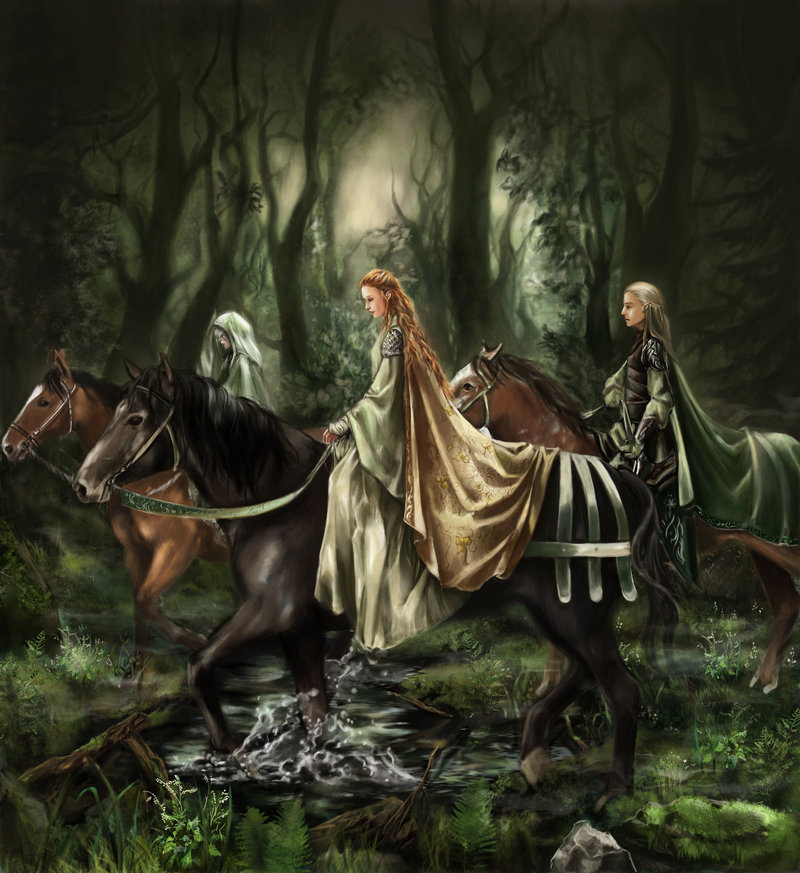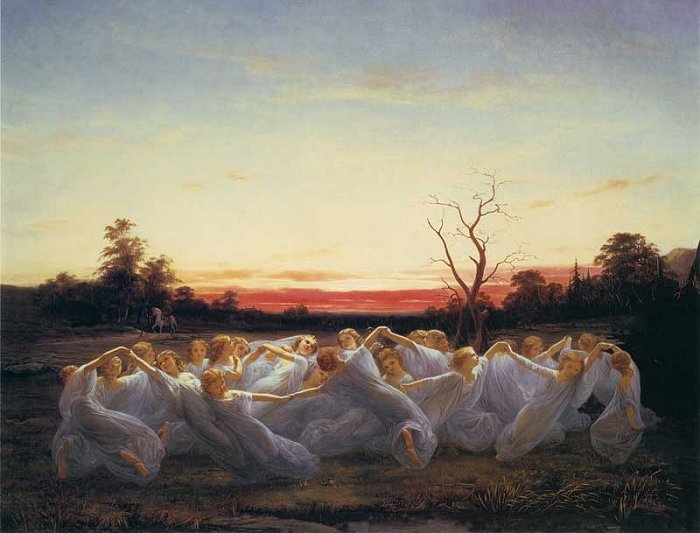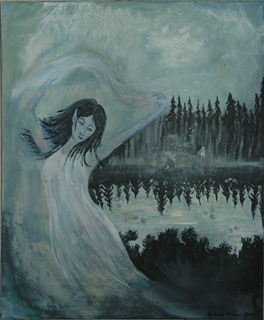 Throughout the eras elves have been seen in different shapes and sizes. One of the most common sorts of elves that most in the 21st century is grown up with, is the elves which lives with Santa Claus. When we grow a little older we meet the Elves of J.R.R. Tolkien wrote about, those with pretty faces, living underground and they are what you'd call High Elves.
Throughout the eras elves have been seen in different shapes and sizes. One of the most common sorts of elves that most in the 21st century is grown up with, is the elves which lives with Santa Claus. When we grow a little older we meet the Elves of J.R.R. Tolkien wrote about, those with pretty faces, living underground and they are what you'd call High Elves.
An elf is a mythical creature of Germanic Mythology/Paganism which still survives in northern European folklore. In Norse mythology they were originally a race of minor gods of nature and fertility. Elves are often pictured as youthful-seeming men and women of great beauty living in forests and other natural places, underground or in wells and springs. They have been portrayed to be long-lived or immortal and they have magical powers attributed to them. Following the success of J. R. R. Tolkien's epic workThe Lord of the Rings—wherein a wise, angelic people named Elves play a significant role—they have become staple characters of modern fantasy (see: Elves in fantasy fiction and games).
Something associated with elves or the qualities of elves is described by the adjectives elven, elvish, elfin or elfish. A convention of modern fantasy usage is: the v in elven or elvish refers to human-sized elves (who correspond more closely to the mythology of the Viking Era), whereas the f in elfin or elfish refers to tiny-sized elfs (who correspond more closely to the folklore of the Renaissance and Romantic Eras).
Elves: the real facts
by XenonZerrow
Elves have many forms; some are tiny, some are tall and female elves often seem humane, but some say they are empty from the back, like a hollow tree.
They are supernatural beings in Germanic mythology and folklore, elves were first attested in Old English and Old Norse texts and are prominent in British and Scandinavian folklore.
Elves were first thought of as ambivalent beings with magical powers, but later they became more and more sinister, harming humans and livestock in various ways. In early modern folklore they were connected with fairies and entered the 20th century mainly by the works of J. R. R. Tolkien.
The English word elf is from the Old English ælf or elf; in compound as ælfadl "nightmare," ælfsogoða "hiccup," afflictions apparently thought to be caused by elves. The Modern German Elf (m), Elfe (f), Elfen is a loan from English.
As in germanic mythology
Jacob Grimm discusses "Wights and Elves" in the work Teutonic Mythology, grouping the elves as a divine or supernatural class of beings. He states that according to Old Norse mythology there are three kinds; the Æsir, the álfar and the vanir.
There is also a close kinship with the dwarves, not only beacause of similar appearance, but many darf has elven name. Derived from several Old Norse scripts dwarves are elves too, but they are the "dark elves", while the "light elves" are what we think of as elves.
Snorri in the Prose Edda states, that light elves live in Álfheim, while dark elves dwell underground, but adds a new term, black elves or dvergar as identified by him, and has them reside in Svartálfaheim. This inspires Grimm to call the dwarves black elves, while the dark elves remain an intermediate class of such beings.
In Old Norse:
The earliest preserved descriptions of elves comes from Norse mythology. In Old Norse they are called álfar.
Men could be elevated to the rank of elves after death, such as king Olaf Geirstad-Elf. The smith hero Völundr is identified as 'Ruler of Elves' in the poem Völundarkviða, who is the son of a king of the 'Finnar'. They are Arctic people respected for their shamanic magic (most likely, the sami).
Crossbreeding is possible according to Norse mythology, Högni and Skuld were such beings. They are also found in the Heimskringla and in The Saga of Thorstein, Viking's Son accounts of a line of local kings who ruled over Álfheim, and since they had elven blood they were said to be more beautiful than most men.
In addition to these human aspects, they are commonly described as semi-divine beings associated with fertility and the cult of the ancestors. Just like ghosts, the elves were not bound by all physical laws and could pass through walls and doors. In addition to this, Kormáks saga accounts for how a sacrifice to elves was apparently believed able to heal a severe battle wound.
In Old English:
Words for the nymphs of the Greek and Roman mythology were translated by Anglo-Saxon scholars as ælf and variants on it, which may point out the origin of English elves.
Old English thinks of elves as harmful creatures. In relation to the beauty of the Norse elves, there are some Old English words such as ælfsciene ("elf-beautiful"). These facts state, that these elves are highly similar to the Norse ones.
Although elves could be considered to be beautiful and potentially helpful beings in some sections of English-speaking society throughout its history, Old English evidence also attests to alignments of elves with demons, as for example in line 112 of Beowulf. On the other hand, oaf is simply a variant of the word elf, presumably originally referring to a changeling or to someone stupefied by elvish enchantment.
Elf shots were considered to be the arrow-heads of elves (and witches), which later also meant a sharp pain (possibly caused by elves). They were considered to have healing power. Later the stones turned out to be Neolithic flint arrow-heads.
In German:
In Christian folklore, the elber began to be described as mischievous pranksters that could cause disease to cattle and people, and bring bad dreams to sleepers. The German word for nightmare, Alptraum, means "elf dream". The archaic form Alpdruck means "elf pressure"; it was believed that nightmares are a result of an elf sitting on the dreamer's chest. This aspect of German elf-belief largely corresponds to the Scandinavian belief in the mara or mera, causing the same problems upon dreaming.
As in modern folklore:![[Untitled] [Untitled]](CXBHWEIhX7qXS2E37wJiew20449.jpg) In Scandinavian folklore:
In Scandinavian folklore:
![[Untitled] [Untitled]](IpvdEm_mS_d9A75f0yryJQ181254.jpg)
If a human man saw them dance, he'd be hypnotised by the dancing and join them. Often the Elven girls would dance him to death, as time slowed when dancing with them. For the man there would only have gone a few hours, while back in the natural world years, maybe even decades would have gone by.

 •Norwegian
•NorwegianIn Icelandic folklore:
Expression of belief in huldufólk or "hidden folk", the elves that dwell in rock formations, is common in Iceland. If the natives do not explicitly express their belief, they are often reluctant to express disbelief. A 2006 and 2007 study on superstition by the University of Iceland’s Faculty of Social Sciences supervised by Terry Gunnell (associate folklore professor), reveal that natives would not rule out the existence of elves and ghosts (similar results of a 1974 survey by Professor Erlendur Haraldsson
In German:
According to German and Danish folklore, the Erlkönig appears as an omen of death, much like the banshee in Irish mythology. Unlike the banshee, however, the Erlkönig will appear only to the person about to die. His form and expression also tell the person what sort of death they will have: a pained expression means a painful death, a peaceful expression means a peaceful death.
In the first story of the Brothers Grimm fairy tale Die Wichtelmänner, the title protagonists are two naked mannequins, which help a shoemaker in his work. When he rewards their work with little clothes, they are so delighted, that they run away and are never seen again. Even though Wichtelmänner are akin to beings such as kobolds, dwarves and brownies, the tale has been translated into English as The Elves and the Shoemaker, and is echoed in J. K. Rowling's Harry Potter stories (another partly incorrect reuse).
Variations of the German elf in folklore include the moss people and the white women. On the latter Jacob Grimm does not make a direct association to the elves, but other researchers see a possible connection to the shining light elves of Old Norse.
In English and Lowland Scottish folklore:
The elf makes many appearances in ballads of English and Scottish origin, as well as folk tales, many involving trips to Elphame or Elfland, a mystical realm which is sometimes an eerie and unpleasant place. The elf is occasionally portrayed in a positive light, but many examples exist of elves of sinister character, frequently bent on rape and murder. In none of the cases is the elf a spritely character with pixie-like qualities.
English folktales of the early modern period commonly portray elves as small, elusive people with mischievous personalities. They are often portrayed as children with Williams syndrome (which was not recognised as a medical condition but some specialist believe that people were enchanted with their character and appearance that they believed to be magical), usually with fair hair. They are not evil but might annoy humans or interfere in their affairs. They are sometimes said to be invisible. In this tradition, elves became similar to the concept of fairies. As people from the English countryside immigrated to America, they brought elements of English folklore with them, and this particular depiction of elves then evolved in America into the Christmas elves of pop culture.
Successively, the word elf, as well as literary term fairy, evolved to a general denotation of various nature spirits like Puck, hobgoblins, Robin Goodfellow, the English and Scots brownie, the Northumbrian English hob and so forth. These terms, like their relatives in other European languages, are no longer clearly distinguished in popular folklore.
The influence of Shakespeare and Michael Drayton made the use of elf and fairy for very small beings the norm. In Victorian literature, elves usually appeared in illustrations as tiny men and women with pointed ears and stocking caps.
The Christmas Elves
In the United States, Canada, the United Kingdom, and Ireland the modern children's folklore of Santa Claus typically includes green-clad elves with pointy ears, long noses, and pointy hats as Santa's helpers or hired workers. They make the toys in a workshop located in the North Pole. In this portrayal, elves slightly resemble nimble and delicate versions of the elves in English folk takes in the Victorian period from which they derived. The role of elves as Santa's helpers has continued to be popular, as evidenced by the success of the popular Christmas movie Elf.
As in modern fantasy:
The fantasy genre in the 20th century grows out of 19th century Romanticism. 19th century scholars such as Andrew Lang and the Grimm brothers collected "fairy-stories" from popular folklore and in some cases retold them freely. A pioneering work of the genre was The King of Elfland's Daughter, a 1924 novel by Lord Dunsany. The Hobbit by J. R. R. Tolkien (1937) is seminal, predating the lecture On Fairy-Stories by the same author by a few years. In the 1939 lecture, Tolkien introduced the term "fantasy" in a sense of "higher form of Art, indeed the most nearly pure form, and so (when achieved) the most potent".Tolkien's writing has such popularity that in the 1960s and afterwards, elves speaking an elvish language similar to those in Tolkien's novels became staple non-human characters in high fantasy works and in fantasy role-playing games.
A hallmark of many fantasy elves is their pointed ears. Post-Tolkien fantasy elves (popularized by Dungeons & Dragons) tend to be more beautiful and wiser than humans, with sharper senses and perceptions. They are said to be gifted with arcane powers, mentally sharp and lovers of nature, art, and song. They are often skilled archers. A hallmark of many fantasy elves is their pointed ears. Thus in every way better than us, which would actually lead to a bloody war out of jealousy between us (and a couple of other imperfect races) and them, which is yet to be told.
NOTE: The guy above me told some truths, but I suggest not to believe that there are only two kind of elves, I actually mentioned more than ten.